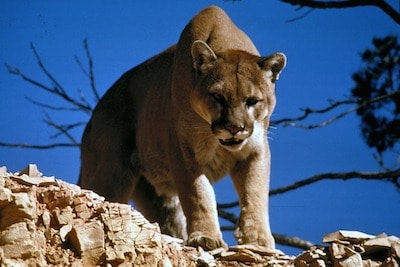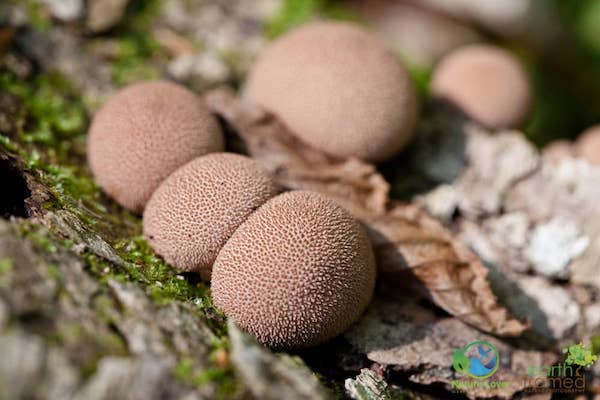The North American Cougar is the largest of three wild cats found in Canada (the other two are the bobcat and the Canada Lynx) and the second largest found in the Americas (the first is the Jaguar). Female cougars average between 35-60 kilograms, while the male cats weigh significantly heavier at 60-100 kilograms. In the wild, they live to be about 10 to 12 years old, but in captivity they have been known to live up to 21 years.
Cougars are very muscular with big front paws and a long, black-tipped tails that they use for balance. They can be various colours depending on the region they live in; tawny red, dark brown or gray. Their throat, chest, chin and whiskers are white. They resemble a domestic cat, more than a lion, with their small heads and short rounded ears. They have dark markings around their muzzles and on the backs of their ears. Unlike other big cats, cougars can’t roar but they do make a large ranges of sounds: purrs, screams, hisses, growls and whistles. These large cats are excellent swimmers and jumpers. From a standing position they can jump straight up 18 feet off the ground or 30-40 feet horizontally! They can also sprint up to speeds of 54 kilometres per hour.
“The cougar works a powerful magic on human imagination.”
– Robert Redford
Habitat
Cougars can most commonly be found in rocky mountains and dark forests but have been known to live in grasslands, swamps and semi-deserts. They find shelter in caves, crevices in rocks, bushes, hollow logs, overturned trees and thick undergrowth. In Canada most of the cougars are found in western Canada, although a few have been spotted across the Prairies, Ontario, Quebec and New Brunswick. Central and Eastern provinces have the cougar listed as endangered and are therefore protected.
Behaviour, Hunting and Range
Depending on the availability of prey, mountain lions may have a small or very large territory that they hunt in. They are solitary, nocturnal hunters and rely on stealth and camouflage to capture their prey. They will silently sneak up on an animal and then leap 30-40 feet, using their very powerful hind legs, to tackle their prey. Cougars are capable of taking down and killing an animal four to six times their size, which means even a 270 kilogram moose could fall victim to this predator. Strictly carnivores, their favourite meal is deer, but mountain lions will often hunt porcupines, Virginia opossums, cottontail rabbits, American Elk (wapiti), beavers and badgers. They have no natural enemies (except man) but they sometimes have to compete with bears and wolves for food.
Reproduction
The only time these solitary animals come together is during mating season and during the upbringing of cubs. Cougars can have two to four kittens every 2-3 years and the mother does all of the parenting. Cubs are born with blue eyes that turn yellow and spotted fur which sheds after 6 months. The cubs stay with their mother for up to two years in order to learn their complicated hunting techniques. After they have left their mother, they may have to travel great distances in order to find an appropriate and available territory for themselves.

Threats
Since they have no wild enemies, the threats to cougar is and has always been – man. When the settlers arrived in the 17th century, people began killing cougars in order to protect livestock. This is one of the primary reasons that so few exist in the eastern parts of North America. Today, they are facing habitat loss and fragmentation, death by automobiles and the continued direct human threat: sport hunting, poaching, poison, snares, traps, hunting dogs, farmers and ranchers.
Human attacks by cougars are very rare in Canada. In the last 100 years only 5 people have been killed by cougar attacks as compared to 3 people per year by bees.
If you are in cougar country, check out these safety tips and information.
[one_third_last]

[/one_third_last]
[two_third_last]
[/two_third_last]
Sources:
“Animal Facts.” Cougar Facts Sheet. Canadian Geographic Kids!, n.d. Web. 21 May 2015. <http://www.canadiangeographic.ca/kids/animal-facts/cougar.asp>.
“CANADIAN ANIMALS Facts – COUGAR ( Also Known as Mountain Lion, Puma, Panther).” CANADIAN ANIMALS Facts – COUGAR ( Also Known as Mountain Lion, Puma, Panther). N.p., n.d. Web. 21 May 2015. <http://www.aitc.sk.ca/saskschools/animals/cougar.html>.
“Cougar.” Nature Conservancy Canada. N.p., n.d. Web. 21 May 2015. <http://www.natureconservancy.ca/en/what-we-do/resource-centre/featured-species/cougar.html>.
“Eastern Cougar.” Nature Canada. N.p., n.d. Web. 21 May 2015. <http://naturecanada.ca/what-we-do/naturevoice/endangered-species/know-our-species/eastern-cougar/>.











